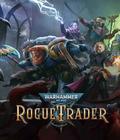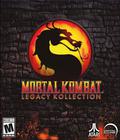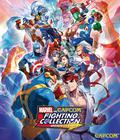Although the physical versions won't hit store shelves until Nov. 22, Marvel vs. Capcom Fighting Collection: Arcade Classics hits digital storefronts on Sept. 12. This means you only have two more weeks before getting your hands on some iconic fighting games without selling a kidney.
After the release of Super Street Fighter II Turbo, Capcom's arcade team produced X-Men: Children of the Atom (1994). A fighting game featuring Marvel's X-Men (with Akuma as a hidden character), CotA largely followed Street Fighter conventions, but it tended toward the flashier side of play. CotA was followed up by Marvel Super Heroes (1995), which based a fighting game around the Infinity Gauntlet storyline long before the Marvel Cinematic Universe was a thing. These games were followed by X-Men vs. Street Fighter (1996), which coalesced the elements that would define the Marvel vs. Capcom franchise, including super jumps, aerial attacks, and hyper combos. If you weren't pushing the limits of fighting game insanity back then, you weren't playing a Marvel vs. Capcom game.
Capcom recently invited me to visit their office and spend some time with a preview build of the upcoming collection. While there, I was able to take both Marvel Super Heroes vs. Street Fighter (1997) and Marvel vs. Capcom (1998) for a spin in addition to taking a peek at the training mode with Marvel vs. Capcom 2 (2000).
After firing up Marvel vs. Capcom, the first thing I noticed was the quality of the visuals. All of these games featured detailed sprite work and multiple frames of animation. Marvel characters were meant to be comic accurate, while the Street Fighter, Darkstalkers, and other Capcom characters were pulled from their various franchises. Sprite work can look a bit rough when viewed raw (the games were designed to be rendered on analog CRTs, and the artwork took the display hardware into account when it was created), so it's key to have a proper filter in place when playing on a modern LCD screen. In this regard, Capcom has done well. Maybe it was nostalgia, but when I sat down to play, Marvel vs. Capcom looked as good as I remember it from the arcade.
Gameplay was fluid, with Marvel vs. Capcom running at 60 frames per second on the PlayStation 5 hardware. This was an issue with some of the older home ports, as the original PlayStation's limited RAM meant that it could not support tag-team gameplay. If you grew up playing on that system instead of the Dreamcast or in the arcade, you played a whole different version of Marvel vs. Capcom.
Speaking of differences, the version of Marvel vs. Capcom in the collection is the arcade version, so unless it's a hidden feature, the Dreamcast exclusive, four-player Cross Fever mode doesn't make an appearance. Secret characters appear to be unlocked by default in this collection. For example, you'd normally have to enter a code before being able to play as Roll in Marvel vs. Capcom. In the preview build, Roll was available simply by selecting the empty space to the right of Mega Man.
Marvel Super Heroes vs. Street Fighter appeared to be running arcade perfect. Back in the day, you had to import a Japanese Sega Saturn copy of the game and the 4MB RAM cart to get the arcade experience at home. Because Marvel Super Heroes vs. Street Fighter only saw an official home console release on the PlayStation in North America, anyone who didn't get the chance to play on an arcade machine likely hasn't seen the original version of this game. Additionally, North American players will also get to play Norimaro (a character created by Japanese comedian Noritake Kinashi) for the first time. Prior to this collection, Norimaro has only been available for play in the original Japanese releases.
Marvel Super Heroes vs. Street Fighter is not quite as polished as Marvel vs. Capcom, but it is interesting to look back and see how the game acts as a stepping stone between the gameplay of X-Men vs. Street Fighter and Marvel vs. Capcom. One key element that was introduced to the franchise in Marvel Super Heroes vs. Street Fighter is the character assist move.
Incidentally, going back to Marvel Super Heroes vs. Street Fighter was also interesting due to the character roster. When the game originally came out, characters like Blackheart and Omega Red were well known among comic fans, but neither have a presence in the current MCU. On the other hand, U.S. Agent (John Walker) will be featured in next year's "Thunderbolts" movie, so maybe everything old is new again.
While I didn't get a chance to look at the collection's museum mode (it was locked in the preview build), the individual games include scans of the original marquee cards. If you wanted to know what kind of instructions Capcom gave arcade players in the '90s, it's here in living color.
Display options include a number of filters, from raw pixels to various CRT emulations. Your choice will likely be a matter of preference, but chances are good that everyone will be able to find something that looks good on their monitor. Additionally, the game lets you change the display size. The default full option approximates an arcade screen with art on the sides, but there are also options for a 4:3 display, and a window boxed original pixel 4:3 display. For some forsaken reason, there is a stretched wide option, but I have no idea why anyone would choose it.
Before my time ended, I took a quick look at training mode with Marvel vs. Capcom 2. It has the features a modern player would expect, with full hitbox and input displays, and a customizable dummy opponent. If you want to set up a specific attack to train against, you can record a series of actions for the dummy to perform and have the computer play it back for you.
While my time with the collection was limited, what I saw has me excited for the full release. The six included fighting games are all landmark titles that clearly show the evolution of the franchise. While most players will likely gravitate toward Marvel vs. Capcom 2, having the other games available provides crucial context. My one big question (since it wasn't available for play) is, "Will Punisher be censored?" given that the collection's ESRB rating is "T" for Teen.
My one big question is, "Why is this collection not being released on Xbox?" Both Capcom Beat 'Em Up Bundle and Capcom Fighting Collection use MT Framework like this collection (Marvel vs. Capcom Fighting Collection: Arcade Classics), and they were released on the Xbox. It's a notable omission, especially for games of this caliber.
More articles about Marvel vs. Capcom Fighting Collection: Arcade Classics











 Marvel vs. Capcom Fighting Collection: Arcade Classics is a jam-packed collection includes seven timeless games in an all-in-one package.
Marvel vs. Capcom Fighting Collection: Arcade Classics is a jam-packed collection includes seven timeless games in an all-in-one package.


























